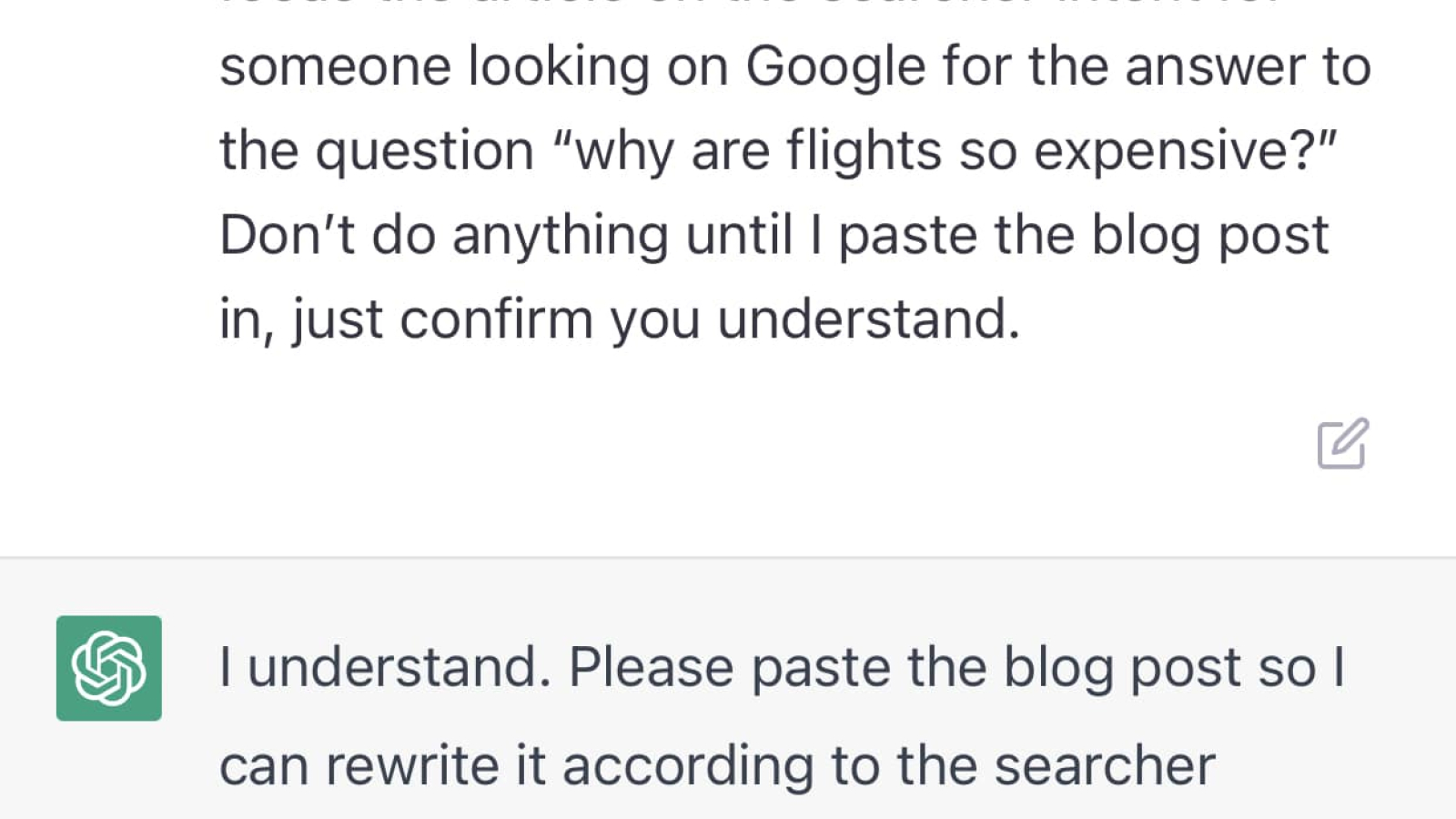
Is ChatGPT your secret weapon for SEO content editing?
Most of the talk surrounding generative AI and SEO centers on content creation. But tools like ChatGPT can help with other specific functions beyond cranking out whole blog posts at scale.
Editing and refreshing content is a vital part of the SEO content lifecycle. This article determines various ways ChatGPT can aid with content editing for SEO.
Editing content with ChatGPT
Before anything else, here are a few caveats to consider when using ChatGPT to edit content:
- ChatGPT often generates answers that may sound accurate (particularly if you’re unfamiliar with a topic) but are completely wrong. A human must constantly review the tool’s outputs before publishing.
- ChatGPT is trained on data from 2021 and prior. It can’t crawl the web as of this writing, so the information it generates may be dated.
- Google has stated there’s no explicit penalty for using AI content as long as it’s helpful. However, a lot of AI content is readily detectable, and there’s no guarantee that that will be Google’s stance forever.
All that said, let’s dive into what ChatGPT can do despite these limitations.
Rewriting for search intent
Let’s imagine our site is focused on the travel industry. A writer just finished a new article on flight costs, and we want it to rank well for the query “Why are flights so expensive?”
We could ask ChatGPT to rewrite the blog post with more of a focus on searcher intent:
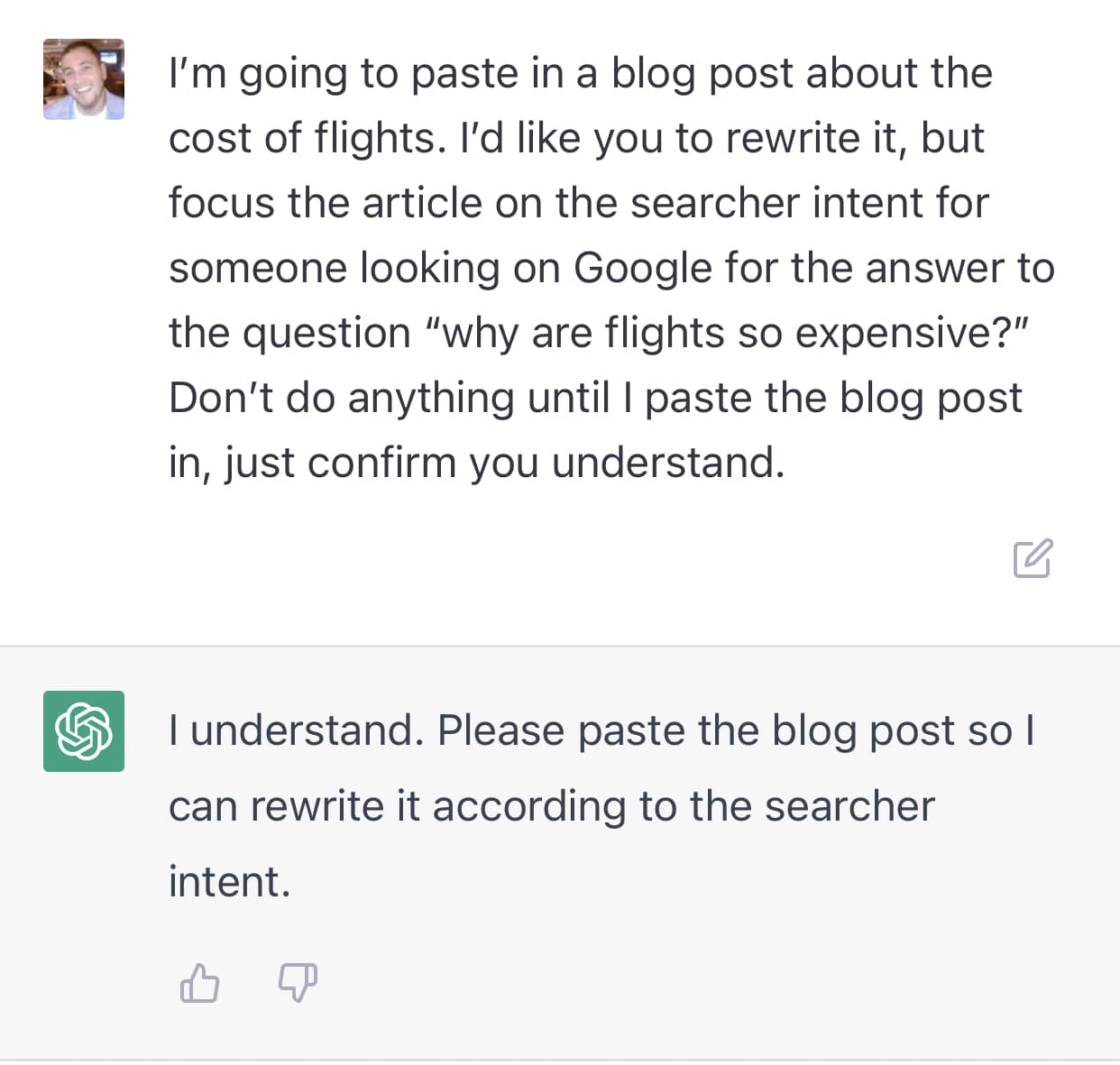
Here is the before and after of what the first paragraph looks like:

If we wanted to dial in the intent a bit more, we could do some things to give ChatGPT more context, like:
- Share the title tags for the top 10 results for the search query to give ChatGPT a better sense of what Google is returning for the search query.
- Share the content (or a summary of the content) for the first result or the first few results Google is returning in the SERP.
- Share some of the search suggestions Google returns when you type the topic into Google.com, or some People also ask questions or related searches.
Remember, if you feed this much information to ChatGPT, the platform can only remember 3,000 words from a conversation. You may have to limit how much information you give in one go.
One option would be to try each of these in their own chats and then compare the results to see which version you feel is the best result.
Applying best practices to your intros
Another thing we can do with ChatGPT goes a step beyond searcher intent. Let’s use the article introduction as an example.
Let’s use Jamie I.F.’s framework for writing introductions:
Let’s try getting ChatGPT to rewrite our newly search-intent-focused blog intro using the S.P.E.A.R. method:

Uh-oh! ChatGPT seemed to grasp the basic idea of the framework out of the gate, but then it went off the rails and mentioned the framework.
My experience is that when ChatGPT gives something this far off, you probably overloaded it with information or made your prompt too complex. (Think of it almost like an overtired or overwhelmed employee!)
Aim to simplify and break your prompts down.
This is also a great reminder to always always always carefully review and edit your ChatGPT output!
Optimizing for featured snippets
I can also share some best practices for optimizing content to get featured snippets with ChatGPT and ask it to rewrite my content:
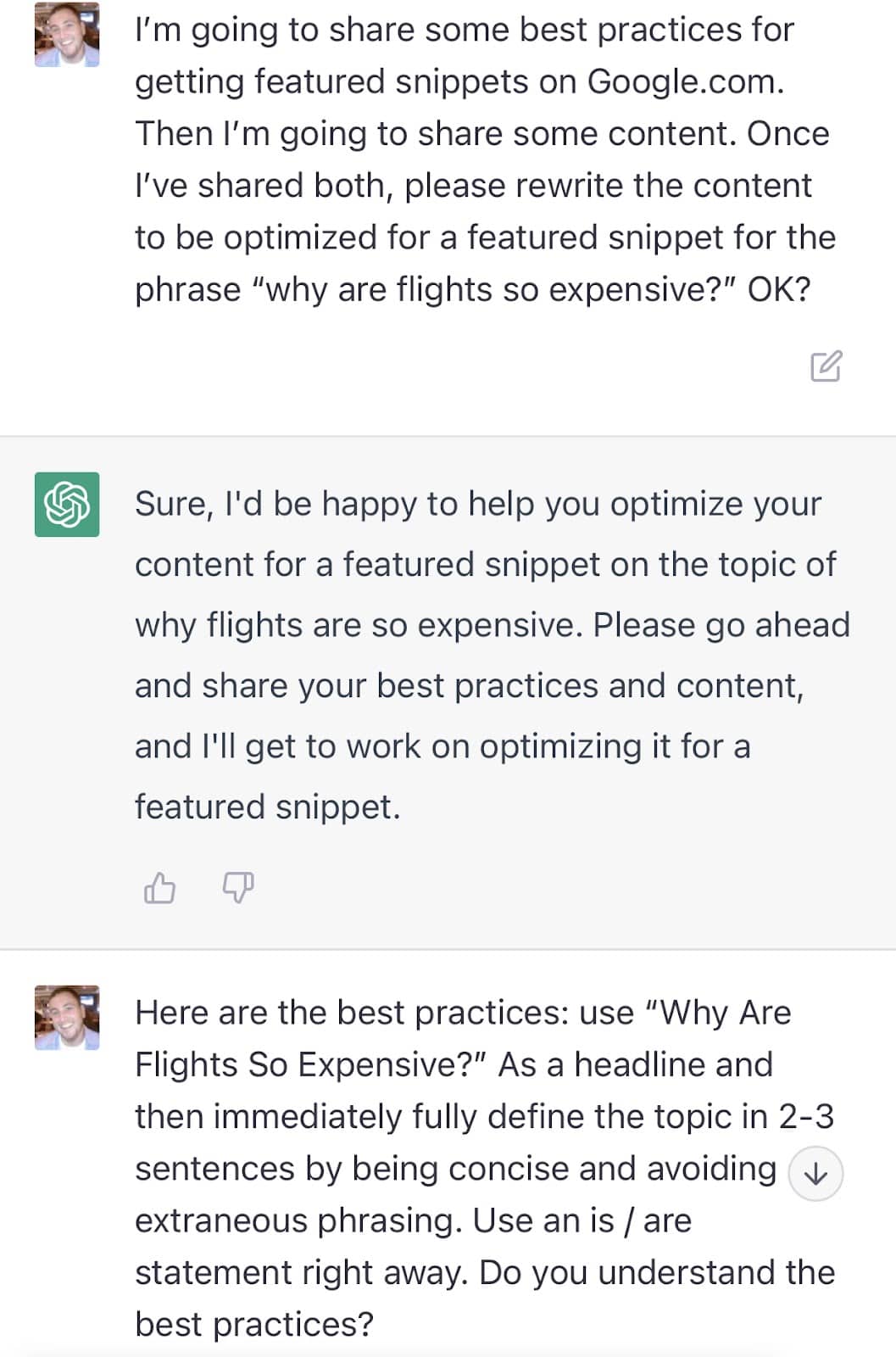
Let’s take a look at the output here:

Again not exactly something I can grab and run with, but this may give me an idea for how to structure a paragraph here.
Adding formatting
A common issue with blog content is that you may receive an article that’s not broken up into subsections and doesn’t use skimmable formatting.
This can lower your content’s engagement and cost you opportunities to optimize for additional keywords.
ChatGPT can help here:

Here is the body of the updated article, which had previously been a few walls of text:

Ideas for additional topics to cover
You can also get ideas from ChatGPT on what your article may be missing. (Of course, ChatGPT isn’t an SEO tool, so these ideas won’t be driven by search suggestions. As long as the subsections are relevant for your readers, they may be helpful.)

You can also find topics or questions specific to your audience.
Look at how different the outputs I get are when I ask for questions someone who doesn’t know anything about the airline industry would ask:

Versus someone who is a frequent traveler:

Adding new subsections to the article
Assuming you’re prepared to review and edit the content, you can also use ChatGPT to create short subsections of content.
Let’s say we wanted to add a subsection to our article about whether airline prices are expected to go down since people are asking and searching for that.
We actually wouldn’t likely want to leave this one with ChatGPT completely since it’s using outdated information, but we could “give it the answer” and ask it to write something for us:

Adding FAQs and FAQ schema
If the author of your blog post hasn’t created an FAQ section already, you can add some FAQs in editing:
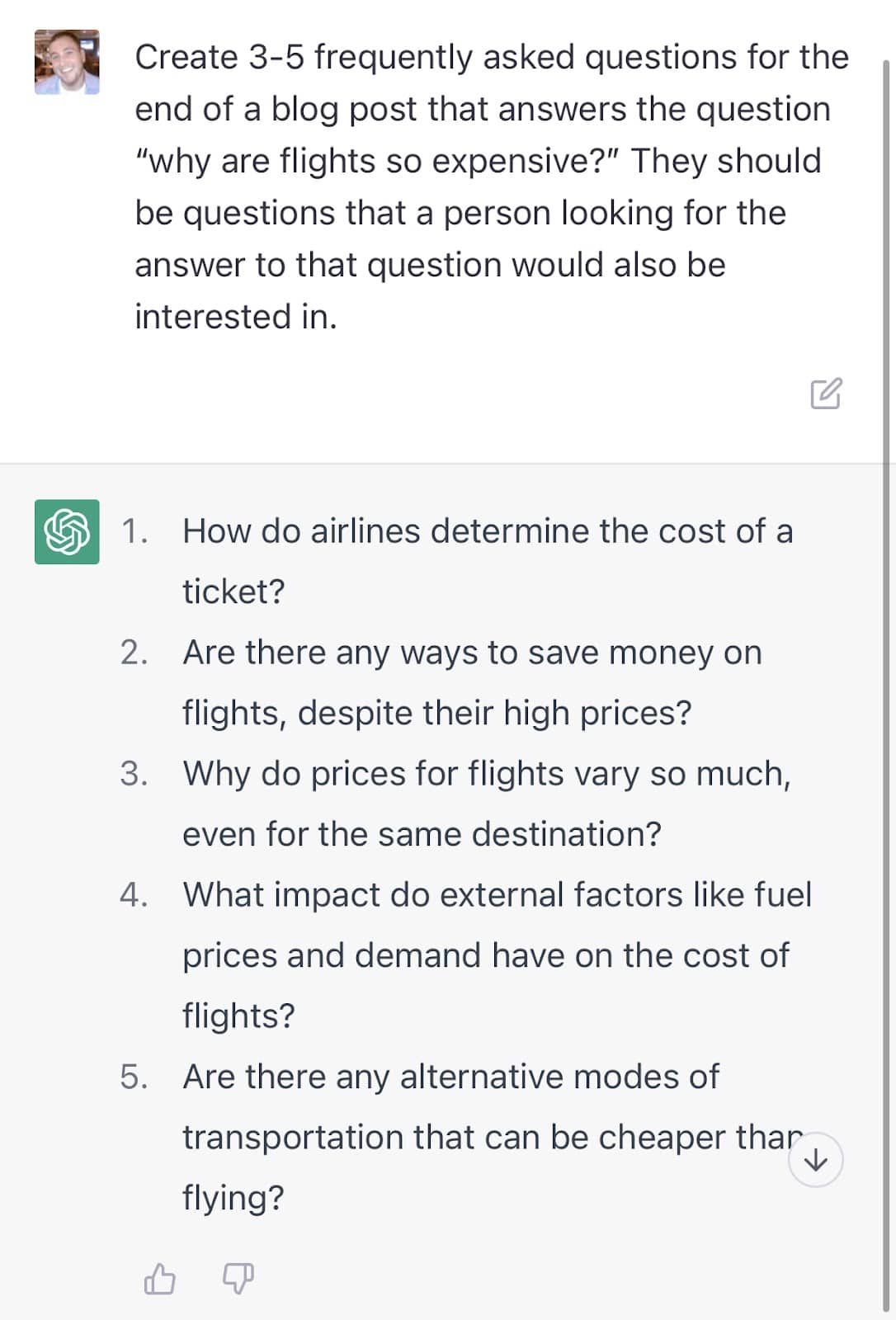
You can also ask ChatGPT to answer these questions for you (always be sure to fact-check):

And finally, you can ask the tool to generate the FAQ schema for you:
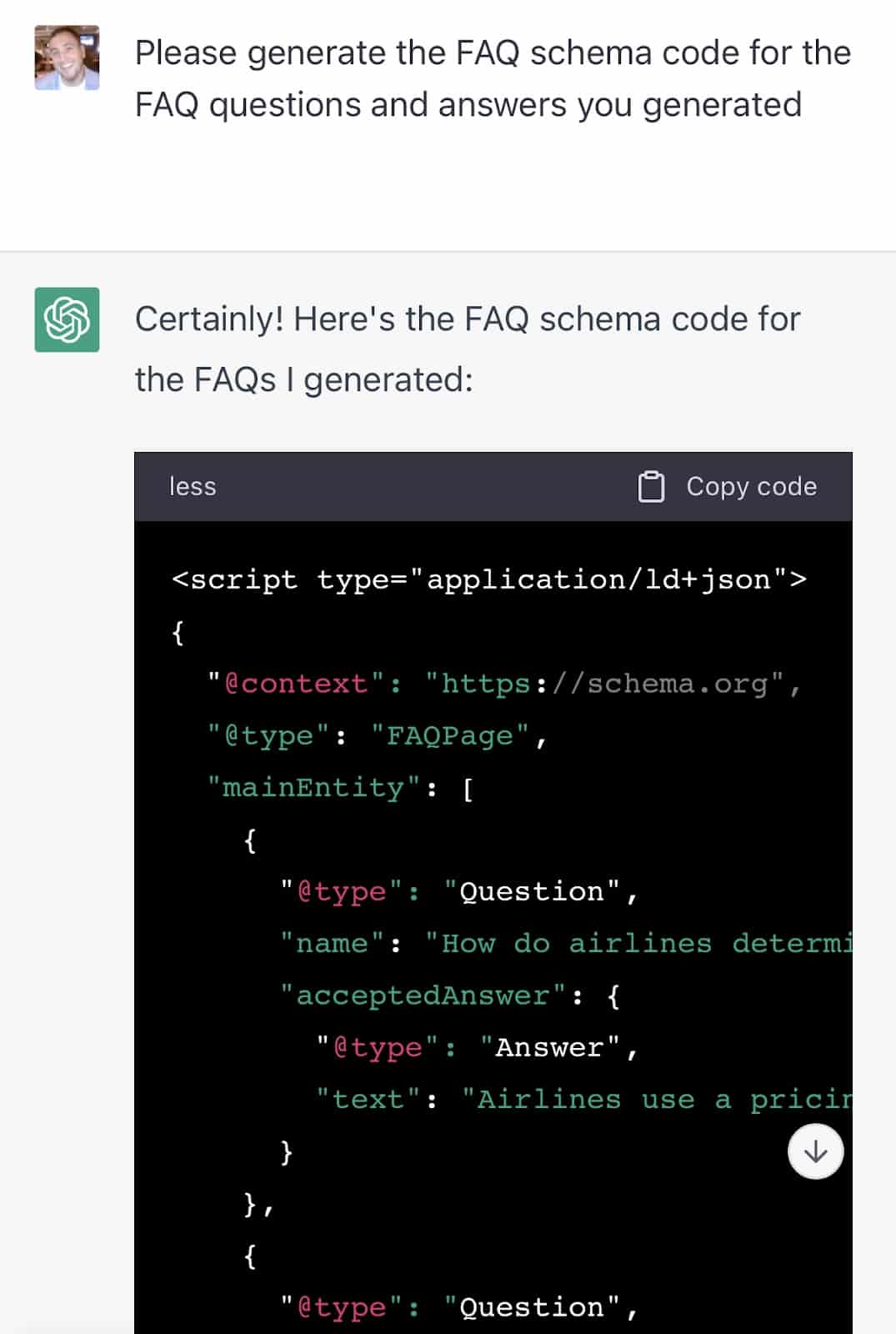
This can help add relevant search-friendly content to your article while giving you extra SERP real estate with FAQ search features.
Beefing up E-E-A-T
Short of training ChatGPT on the quality rater guidelines, you can still get some ideas for making your article more credible:

These aren’t the most innovative E-E-A-T ideas, but they may be good reminders of different options. What if I have ChatGPT just edit the article to add some E-E-A-T for me:

So ChatGPT punted on the first E in E-E-A-T altogether but then told the reader about all my experience in the travel industry.
Except I never told ChatGPT I worked in the travel industry, and it was never mentioned in the original article!
The rest of the article is pretty similar to the original one, so it doesn’t look like ChatGPT is much of an E-E-A-T editor.
(Of course, the update from E-A-T to E-E-A-T happened after the training period for GPT-3, so ChatGPT won’t be aware of that outside of the context I gave it).
Updating outdated information
Since ChatGPT’s training data is from before 2021, updating outdated information won’t suit the platform.
But there are some specific instances where you could use the tool for this purpose, such as:
- Report summaries: Asking ChatGPT to read and summarize a new study could infuse fresh data into an older article.
- New version of an old report: Similarly, if a page references an older report that’s been updated (e.g., the 2017 State of Air Travel), you could find the newer version and then swap that out in place of the reference to the older report.
- Annual reports: While ChatGPT can’t necessarily find you fresh data or studies, one workaround for this is to ask the tool to surface reports that are produced annually. That points you in the direction of the report so you can go and grab the latest version.

Rewriting for style
Finding the right tone or sentiment may help a piece of content get shared, have better engagement metrics, or convert better.
If I want to make my content more sensational, I could ask ChatGPT to turn up the outrage:

Or, disturbingly, I can point ChatGPT’s outrage at whomever I’d like:

You could also pivot the article to have a specific perspective and a more sympathetic sentiment to try to relate to visitors:

Convert post to HTML and add internal links
Converting posts from a Google Doc or Word Doc is often part of the editorial workflow. ChatGPT can often accomplish this task very quickly:

From there, you can get ChatGPT’s help with another common SEO editing task – adding internal links to an article:
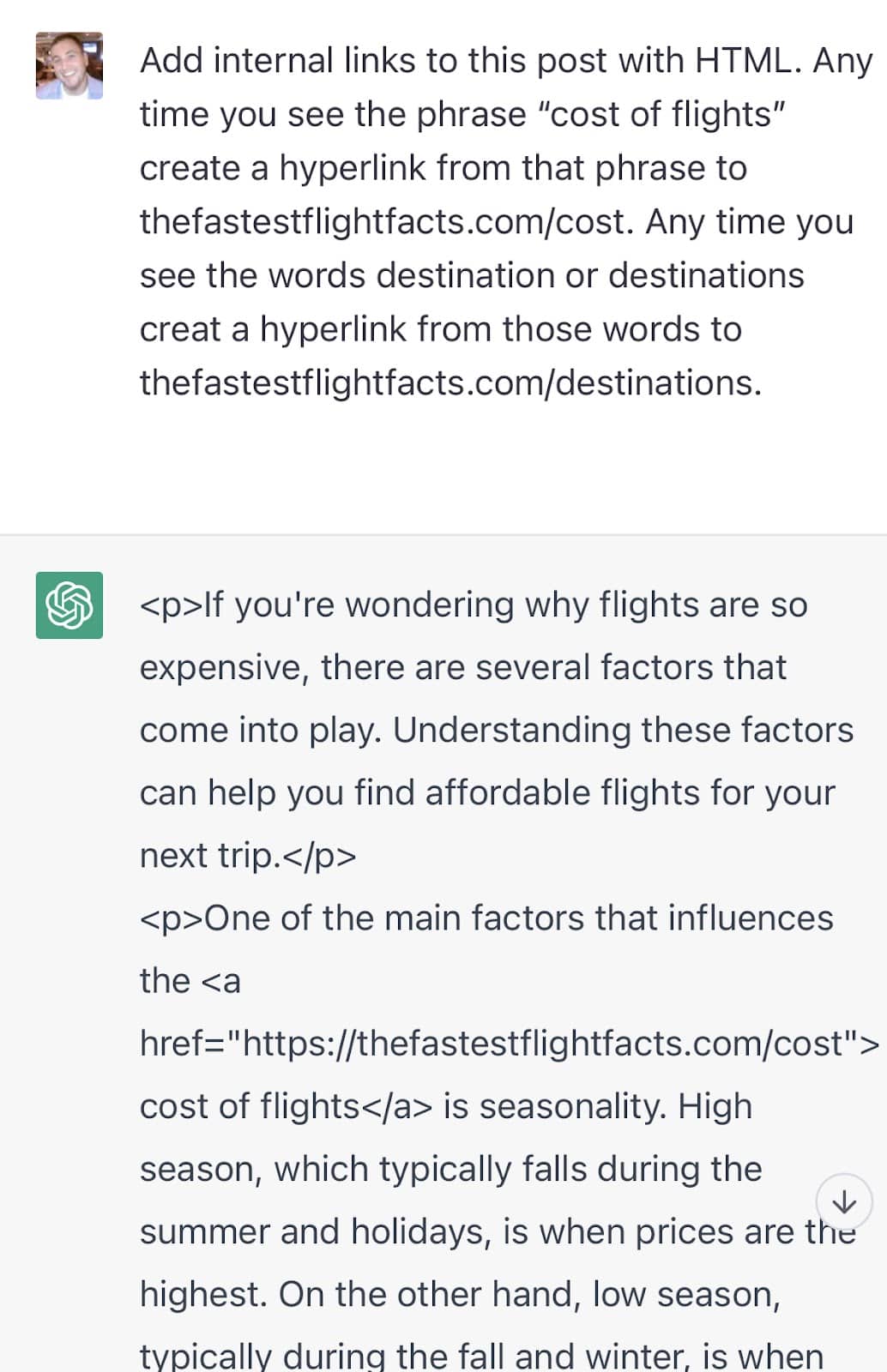
If you have a longer form article and know the URLs and associated anchor text you want to focus on, this can help create those links quickly.
Obviously, this isn’t a substitute for both knowing which pages you want to link to from your new article or for identifying the best pages to have link to your new content (or the piece you’re updating).
Translations
Are you translating content from one language to another to capture more traffic from search in different languages? ChatGPT can help.
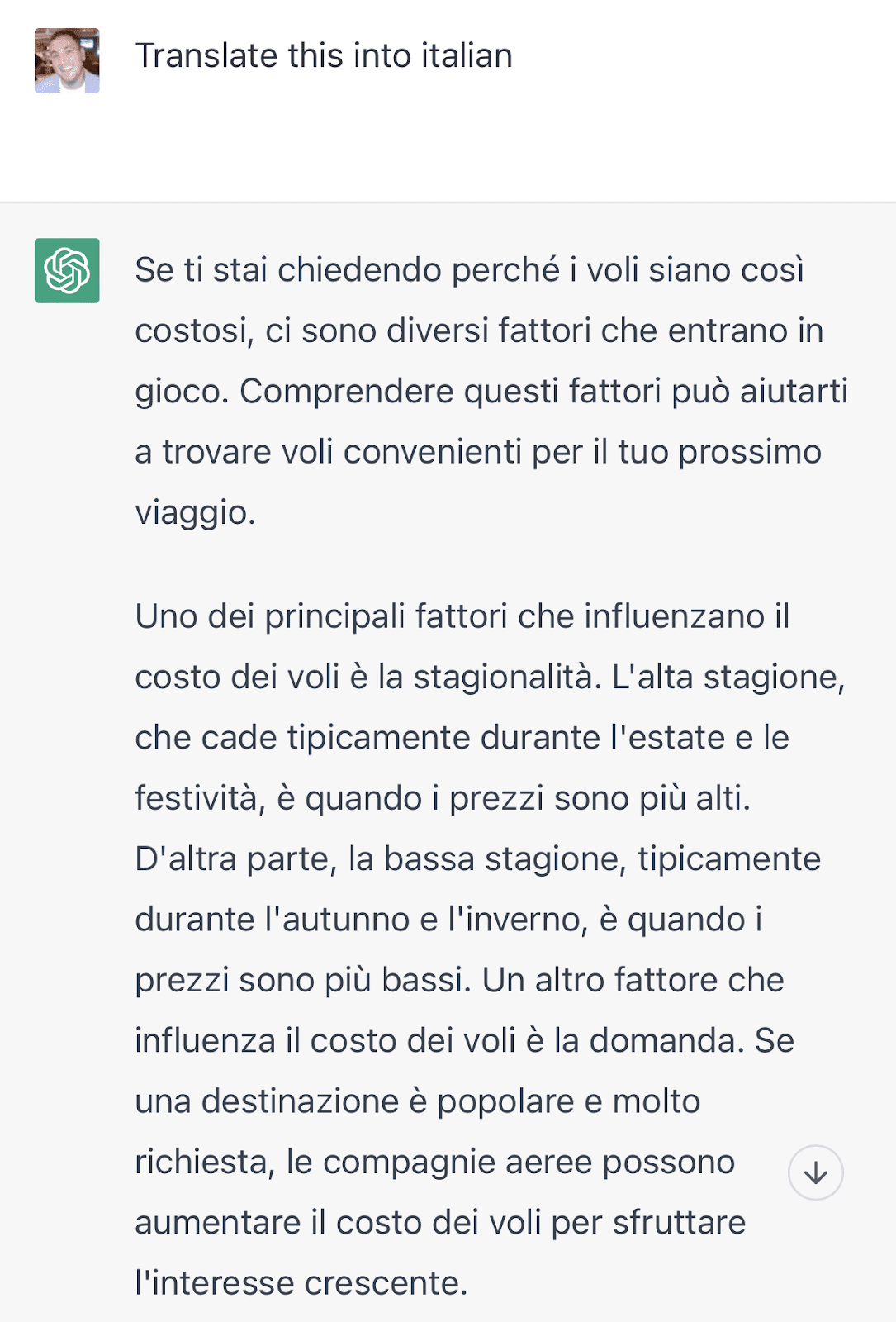
As always, it’s a good idea to have someone who knows the language you’re publishing to your site QA the output here before you push it live.
Bonus: Video and podcast transcriptions
This isn’t something ChatGPT can help with strictly speaking, but Open AI did recently announce that both ChatGPT and Whisper now have APIs.
Whisper is an automatic speech recognition system that can take transcriptions from audio in multiple languages.
You can use the Whisper API to add a transcription of your video or podcast to generate crawlable text from your audio content:
When to use ChatGPT for SEO editing tasks
While some of these functions may be things that ChatGPT can do, it doesn’t mean it will be the best option for that specific task for your piece of content or your workflow.
There are a few factors that help determine how “qualified” ChatGPT will be for a job:
- If you have a topic or task that requires freshness or recent info it’s likely not a fit.
- If you have a complex prompt – something that requires ChatGPT to execute multiple tasks at once or will require you to “feed” the platform more than the maximum 3,000 characters in a chat, then it’s likely not a fit (or at the very least you need to determine a way to break up your tasks).
- If you need ideas or variations of something or are just stuck and need some inspiration to get moving on things like a new section of an article, title ideas, etc. ChatGPT can be very useful.
If you find the tool useful in some areas but not others, I’d also encourage you to keep a running “wish list” of tasks where it’s close but not good enough.
Open AI quickly releases new versions of the underlying GPT technology and various Open AI APIs. Simultaneously, they also make rapid platform updates.
Its limitations (i.e., character limits through the API or web interface, how much ChatGPT can remember in a conversation, data freshness, and the number of tasks it can perform through a complicated prompt) will likely improve.
Keep an eye on what’s changing in future updates and how that may impact your not-quite-there-yet task.
The post Is ChatGPT your secret weapon for SEO content editing? appeared first on Search Engine Land.
from Search Engine Land https://searchengineland.com/chatgpt-seo-content-editing-394670
via free Seo Tools


 Download YT videos
Download YT videos